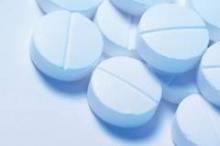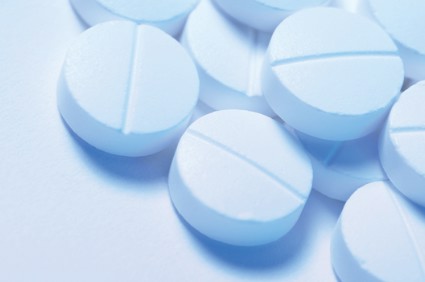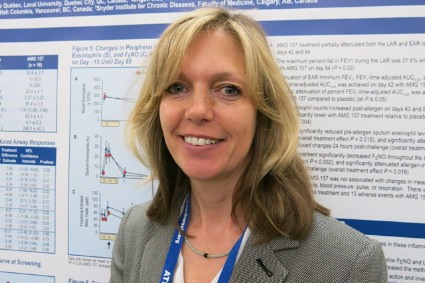User login
Acetaminophen in ICU may be renoprotective
SAN DIEGO – Three days of acetaminophen seemed to lower creatinine levels in severely septic patients, suggesting a renoprotective effect, according to results from a phase II study out of Vanderbilt University in Nashville, Tenn.
Investigators there randomized 18 septic ICU patients to acetaminophen 1 g every 6 hours for 3 days and 22 patients to placebo, both delivered by mouth or feeding tube. The patients had all been in the ICU for less than 24 hours, and had detectable levels of plasma cell-free hemoglobin (CFH).
The findings were presented at an international conference of the American Thoracic Society.
CFH has been associated with death in a number of conditions. The iron separates, radicalizes, and causes oxidative injury, especially to the kidneys. Acetaminophen chemically reduces the iron, and has been shown to counter the harm.
In an earlier observational study, the Vanderbilt team found that detectible CFH is common in ICU sepsis patients, as well as elevated plasma levels of F2-isoprostanes, an indicator of oxidative injury. They also observed that CFH was associated with death, and that exposure to acetaminophen seemed to reduce F2-isoprostanes levels and improve survival (Crit Care Med. 2013;41:784-90).
The findings prompted the phase II investigation. The team found that the acetaminophen group had lower levels of F2-isoprostanes on study day 2 (mean 24.9 pg/mL vs. 41.2 pg/mL) and lower levels of serum creatinine on study day 3 (mean 1.0 mg/dL vs. 1.3 mg/dL). These differences were significant and the renal benefit persisted throughout hospitalization.
Acetaminophen patients overall started with a lower mean baseline creatinine level (1.63 mg/dL vs. 2.06 mg/dL), so the investigators reran their analysis, excluding patients on renal replacement therapy. "The baseline imbalance went away, and the story remained the same: There was still a significant decrease in serum creatinine in the acetaminophen group," said lead investigator Dr. David Janz, a critical care fellow at Vanderbilt.
Despite a favorable trend, acetaminophen did not significantly improve survival, a secondary outcome; one (5.6%) acetaminophen and four (18.2%) placebo patients died.
Still, the results are strong enough to suggest that acetaminophen might one day prove to be "a potent intervention to improve sepsis outcomes. Even small creatinine changes are associated with increased length of stay and mortality," Dr. Janz said.
"Our trial contains some negative results" – most notably no significant effect on day 3 F2-isoprostanes levels – but "the consistent reduction in creatinine across a number of different analyses and the biologic plausibility underlying this signal prompt further investigation. We need larger studies that focus on length of stay and mortality," he said.
Acetaminophen patients were slightly younger (50 vs. 58 years), but besides that and the baseline creatinine difference, the groups were well matched. Both had mean Apache II scores in the low 20s. Nine acetaminophen patients (50%) and seven placebo patients (32%) were intubated.
Both groups received a median of 12 study doses. There was no statistical between-group difference in the number of patients whose AST/ALT topped 400 U/L, a stop-point hit by two acetaminophen patients and one placebo patient. No one in the acetaminophen group developed a rash.
Patients who had liver disease or who had gotten acetaminophen within 48 hours were among those excluded from the study.
The work was funded by the National Institutes of Health and the American Heart Association. Dr. Janz had no disclosures.
Dr. Eleanor Summerhill, FCCP, comments: This small, phase II randomized, double-blind, placebo-controlled pilot study suggests that acetaminophen may play a future therapeutic role in the amelioration of oxidative injury–induced multisystem organ failure. Clearly, more investigation is necessary.
The study was small, so despite randomization, there were differences in the two treatment groups in regard to age and baseline creatinine levels (the latter corrected for in a secondary analysis). In addition, the effect on oxidative injury markers was not robust beyond day 2. Finally, the study was underpowered for important outcomes such as hospital length of stay and mortality.
The current study adds to the body of literature demonstrating that acetaminophen inhibits hemoprotein-mediated lipid peroxidation in vitro and in animal models. It also builds upon a previous observational study showing that high plasma cell-free hemoglobin concentrations were associated with poor outcomes in sepsis, and that acetaminophen decreased serum markers of oxidative stress as well as mortality.
Dr. Eleanor Summerhill, FCCP, comments: This small, phase II randomized, double-blind, placebo-controlled pilot study suggests that acetaminophen may play a future therapeutic role in the amelioration of oxidative injury–induced multisystem organ failure. Clearly, more investigation is necessary.
The study was small, so despite randomization, there were differences in the two treatment groups in regard to age and baseline creatinine levels (the latter corrected for in a secondary analysis). In addition, the effect on oxidative injury markers was not robust beyond day 2. Finally, the study was underpowered for important outcomes such as hospital length of stay and mortality.
The current study adds to the body of literature demonstrating that acetaminophen inhibits hemoprotein-mediated lipid peroxidation in vitro and in animal models. It also builds upon a previous observational study showing that high plasma cell-free hemoglobin concentrations were associated with poor outcomes in sepsis, and that acetaminophen decreased serum markers of oxidative stress as well as mortality.
Dr. Eleanor Summerhill, FCCP, comments: This small, phase II randomized, double-blind, placebo-controlled pilot study suggests that acetaminophen may play a future therapeutic role in the amelioration of oxidative injury–induced multisystem organ failure. Clearly, more investigation is necessary.
The study was small, so despite randomization, there were differences in the two treatment groups in regard to age and baseline creatinine levels (the latter corrected for in a secondary analysis). In addition, the effect on oxidative injury markers was not robust beyond day 2. Finally, the study was underpowered for important outcomes such as hospital length of stay and mortality.
The current study adds to the body of literature demonstrating that acetaminophen inhibits hemoprotein-mediated lipid peroxidation in vitro and in animal models. It also builds upon a previous observational study showing that high plasma cell-free hemoglobin concentrations were associated with poor outcomes in sepsis, and that acetaminophen decreased serum markers of oxidative stress as well as mortality.
SAN DIEGO – Three days of acetaminophen seemed to lower creatinine levels in severely septic patients, suggesting a renoprotective effect, according to results from a phase II study out of Vanderbilt University in Nashville, Tenn.
Investigators there randomized 18 septic ICU patients to acetaminophen 1 g every 6 hours for 3 days and 22 patients to placebo, both delivered by mouth or feeding tube. The patients had all been in the ICU for less than 24 hours, and had detectable levels of plasma cell-free hemoglobin (CFH).
The findings were presented at an international conference of the American Thoracic Society.
CFH has been associated with death in a number of conditions. The iron separates, radicalizes, and causes oxidative injury, especially to the kidneys. Acetaminophen chemically reduces the iron, and has been shown to counter the harm.
In an earlier observational study, the Vanderbilt team found that detectible CFH is common in ICU sepsis patients, as well as elevated plasma levels of F2-isoprostanes, an indicator of oxidative injury. They also observed that CFH was associated with death, and that exposure to acetaminophen seemed to reduce F2-isoprostanes levels and improve survival (Crit Care Med. 2013;41:784-90).
The findings prompted the phase II investigation. The team found that the acetaminophen group had lower levels of F2-isoprostanes on study day 2 (mean 24.9 pg/mL vs. 41.2 pg/mL) and lower levels of serum creatinine on study day 3 (mean 1.0 mg/dL vs. 1.3 mg/dL). These differences were significant and the renal benefit persisted throughout hospitalization.
Acetaminophen patients overall started with a lower mean baseline creatinine level (1.63 mg/dL vs. 2.06 mg/dL), so the investigators reran their analysis, excluding patients on renal replacement therapy. "The baseline imbalance went away, and the story remained the same: There was still a significant decrease in serum creatinine in the acetaminophen group," said lead investigator Dr. David Janz, a critical care fellow at Vanderbilt.
Despite a favorable trend, acetaminophen did not significantly improve survival, a secondary outcome; one (5.6%) acetaminophen and four (18.2%) placebo patients died.
Still, the results are strong enough to suggest that acetaminophen might one day prove to be "a potent intervention to improve sepsis outcomes. Even small creatinine changes are associated with increased length of stay and mortality," Dr. Janz said.
"Our trial contains some negative results" – most notably no significant effect on day 3 F2-isoprostanes levels – but "the consistent reduction in creatinine across a number of different analyses and the biologic plausibility underlying this signal prompt further investigation. We need larger studies that focus on length of stay and mortality," he said.
Acetaminophen patients were slightly younger (50 vs. 58 years), but besides that and the baseline creatinine difference, the groups were well matched. Both had mean Apache II scores in the low 20s. Nine acetaminophen patients (50%) and seven placebo patients (32%) were intubated.
Both groups received a median of 12 study doses. There was no statistical between-group difference in the number of patients whose AST/ALT topped 400 U/L, a stop-point hit by two acetaminophen patients and one placebo patient. No one in the acetaminophen group developed a rash.
Patients who had liver disease or who had gotten acetaminophen within 48 hours were among those excluded from the study.
The work was funded by the National Institutes of Health and the American Heart Association. Dr. Janz had no disclosures.
SAN DIEGO – Three days of acetaminophen seemed to lower creatinine levels in severely septic patients, suggesting a renoprotective effect, according to results from a phase II study out of Vanderbilt University in Nashville, Tenn.
Investigators there randomized 18 septic ICU patients to acetaminophen 1 g every 6 hours for 3 days and 22 patients to placebo, both delivered by mouth or feeding tube. The patients had all been in the ICU for less than 24 hours, and had detectable levels of plasma cell-free hemoglobin (CFH).
The findings were presented at an international conference of the American Thoracic Society.
CFH has been associated with death in a number of conditions. The iron separates, radicalizes, and causes oxidative injury, especially to the kidneys. Acetaminophen chemically reduces the iron, and has been shown to counter the harm.
In an earlier observational study, the Vanderbilt team found that detectible CFH is common in ICU sepsis patients, as well as elevated plasma levels of F2-isoprostanes, an indicator of oxidative injury. They also observed that CFH was associated with death, and that exposure to acetaminophen seemed to reduce F2-isoprostanes levels and improve survival (Crit Care Med. 2013;41:784-90).
The findings prompted the phase II investigation. The team found that the acetaminophen group had lower levels of F2-isoprostanes on study day 2 (mean 24.9 pg/mL vs. 41.2 pg/mL) and lower levels of serum creatinine on study day 3 (mean 1.0 mg/dL vs. 1.3 mg/dL). These differences were significant and the renal benefit persisted throughout hospitalization.
Acetaminophen patients overall started with a lower mean baseline creatinine level (1.63 mg/dL vs. 2.06 mg/dL), so the investigators reran their analysis, excluding patients on renal replacement therapy. "The baseline imbalance went away, and the story remained the same: There was still a significant decrease in serum creatinine in the acetaminophen group," said lead investigator Dr. David Janz, a critical care fellow at Vanderbilt.
Despite a favorable trend, acetaminophen did not significantly improve survival, a secondary outcome; one (5.6%) acetaminophen and four (18.2%) placebo patients died.
Still, the results are strong enough to suggest that acetaminophen might one day prove to be "a potent intervention to improve sepsis outcomes. Even small creatinine changes are associated with increased length of stay and mortality," Dr. Janz said.
"Our trial contains some negative results" – most notably no significant effect on day 3 F2-isoprostanes levels – but "the consistent reduction in creatinine across a number of different analyses and the biologic plausibility underlying this signal prompt further investigation. We need larger studies that focus on length of stay and mortality," he said.
Acetaminophen patients were slightly younger (50 vs. 58 years), but besides that and the baseline creatinine difference, the groups were well matched. Both had mean Apache II scores in the low 20s. Nine acetaminophen patients (50%) and seven placebo patients (32%) were intubated.
Both groups received a median of 12 study doses. There was no statistical between-group difference in the number of patients whose AST/ALT topped 400 U/L, a stop-point hit by two acetaminophen patients and one placebo patient. No one in the acetaminophen group developed a rash.
Patients who had liver disease or who had gotten acetaminophen within 48 hours were among those excluded from the study.
The work was funded by the National Institutes of Health and the American Heart Association. Dr. Janz had no disclosures.
Key clinical point: Acetaminophen might protect septic patients’ kidneys.
Major finding: After 3 days, 18 septic ICU patients randomized to acetaminophen had a mean serum creatinine of 1.0 mg/dL; 22 randomized to placebo had a mean serum creatinine of 1.3 mg/dL (P = .039).
Data source: A phase II trial.
Disclosures: The work was funded by the National Institutes of Health and the American Heart Association. The lead investigator had no disclosures.
Monoclonal antibody attacks new asthma target
SAN DIEGO – An investigational human monoclonal antibody suggested a new approach to asthma treatment by showing evidence of anti-inflammatory activity and partial attenuation of early and late asthmatic responses in a proof-of-concept study of 31 patients with mild asthma.
Patients were randomized to intravenous treatment with AMG 157 or placebo for up to 3 months before undergoing allergen-induced challenge and testing. AMG 157 binds human thymic stromal lymphopoietin (TSLP), an epithelial cell–derived cytokine that might be important in initiating allergic inflammation, and prevents receptor interaction.
By day 84, the maximum percentage decrease in the forced expiratory volume at 1 second (FEV1) during late asthmatic response (3-7 hours after allergy challenge) was 46% smaller in the treatment group, vs. placebo, a significant difference, Gail M. Gauvreau, Ph.D., and her associates reported at an international conference of the American Thoracic Society.
Among secondary outcomes, the area under the curve (AUC) of the time-adjusted percent decrease in FEV1 during the early asthmatic response was significantly smaller in the treatment group than the control group on day 84. Patients who got AMG 157 showed significantly lower levels of blood and sputum eosinophils before and after allergy challenge and in the fraction of exhaled nitric oxide.
Adverse events were reported in 15 patients on AMG 157 and 12 patients on placebo. No serious adverse events were seen, reported Dr. Gauvreau of the Firestone Institute of Respiratory Health at McMaster University, Hamilton, Ont.
The study was published online by the New England Journal of Medicine (2014 May 20 [doi: 10.1056/NEJMoa1402895]). "This proof-of-concept study suggests that TSLP is a pivotal cytokine not only in allergen-induced airway responses but also in persistent airway inflammation in patients with allergic asthma," the investigators wrote.
The company that is developing AMG 157 has started a phase II clinical trial, Dr. Gauvreau said in an interview at the meeting.
The population of mild asthmatics in the proof-of-concept study is not the kind of patient who might use this treatment, she said, but this potential treatment pathway offers hope for a new therapy for patients with steroid-resistant asthma.
Amgen, which is developing AMG 157, funded the study and analyzed the data. Many of the researchers reported financial associations with Amgen and other companies.
On Twitter @sherryboschert
 |
|
Dr. Eric Gartman, FCCP, comments: For our most difficult-to-control asthma patients, we are longing for an effective and more directed alternative to systemic corticosteroids. While this agent has yet to be studied in the appropriate population, any advancement in the science of developing therapies against novel targets in asthma is a needed step in the right direction.
 |
|
Dr. Eric Gartman, FCCP, comments: For our most difficult-to-control asthma patients, we are longing for an effective and more directed alternative to systemic corticosteroids. While this agent has yet to be studied in the appropriate population, any advancement in the science of developing therapies against novel targets in asthma is a needed step in the right direction.
 |
|
Dr. Eric Gartman, FCCP, comments: For our most difficult-to-control asthma patients, we are longing for an effective and more directed alternative to systemic corticosteroids. While this agent has yet to be studied in the appropriate population, any advancement in the science of developing therapies against novel targets in asthma is a needed step in the right direction.
SAN DIEGO – An investigational human monoclonal antibody suggested a new approach to asthma treatment by showing evidence of anti-inflammatory activity and partial attenuation of early and late asthmatic responses in a proof-of-concept study of 31 patients with mild asthma.
Patients were randomized to intravenous treatment with AMG 157 or placebo for up to 3 months before undergoing allergen-induced challenge and testing. AMG 157 binds human thymic stromal lymphopoietin (TSLP), an epithelial cell–derived cytokine that might be important in initiating allergic inflammation, and prevents receptor interaction.
By day 84, the maximum percentage decrease in the forced expiratory volume at 1 second (FEV1) during late asthmatic response (3-7 hours after allergy challenge) was 46% smaller in the treatment group, vs. placebo, a significant difference, Gail M. Gauvreau, Ph.D., and her associates reported at an international conference of the American Thoracic Society.
Among secondary outcomes, the area under the curve (AUC) of the time-adjusted percent decrease in FEV1 during the early asthmatic response was significantly smaller in the treatment group than the control group on day 84. Patients who got AMG 157 showed significantly lower levels of blood and sputum eosinophils before and after allergy challenge and in the fraction of exhaled nitric oxide.
Adverse events were reported in 15 patients on AMG 157 and 12 patients on placebo. No serious adverse events were seen, reported Dr. Gauvreau of the Firestone Institute of Respiratory Health at McMaster University, Hamilton, Ont.
The study was published online by the New England Journal of Medicine (2014 May 20 [doi: 10.1056/NEJMoa1402895]). "This proof-of-concept study suggests that TSLP is a pivotal cytokine not only in allergen-induced airway responses but also in persistent airway inflammation in patients with allergic asthma," the investigators wrote.
The company that is developing AMG 157 has started a phase II clinical trial, Dr. Gauvreau said in an interview at the meeting.
The population of mild asthmatics in the proof-of-concept study is not the kind of patient who might use this treatment, she said, but this potential treatment pathway offers hope for a new therapy for patients with steroid-resistant asthma.
Amgen, which is developing AMG 157, funded the study and analyzed the data. Many of the researchers reported financial associations with Amgen and other companies.
On Twitter @sherryboschert
SAN DIEGO – An investigational human monoclonal antibody suggested a new approach to asthma treatment by showing evidence of anti-inflammatory activity and partial attenuation of early and late asthmatic responses in a proof-of-concept study of 31 patients with mild asthma.
Patients were randomized to intravenous treatment with AMG 157 or placebo for up to 3 months before undergoing allergen-induced challenge and testing. AMG 157 binds human thymic stromal lymphopoietin (TSLP), an epithelial cell–derived cytokine that might be important in initiating allergic inflammation, and prevents receptor interaction.
By day 84, the maximum percentage decrease in the forced expiratory volume at 1 second (FEV1) during late asthmatic response (3-7 hours after allergy challenge) was 46% smaller in the treatment group, vs. placebo, a significant difference, Gail M. Gauvreau, Ph.D., and her associates reported at an international conference of the American Thoracic Society.
Among secondary outcomes, the area under the curve (AUC) of the time-adjusted percent decrease in FEV1 during the early asthmatic response was significantly smaller in the treatment group than the control group on day 84. Patients who got AMG 157 showed significantly lower levels of blood and sputum eosinophils before and after allergy challenge and in the fraction of exhaled nitric oxide.
Adverse events were reported in 15 patients on AMG 157 and 12 patients on placebo. No serious adverse events were seen, reported Dr. Gauvreau of the Firestone Institute of Respiratory Health at McMaster University, Hamilton, Ont.
The study was published online by the New England Journal of Medicine (2014 May 20 [doi: 10.1056/NEJMoa1402895]). "This proof-of-concept study suggests that TSLP is a pivotal cytokine not only in allergen-induced airway responses but also in persistent airway inflammation in patients with allergic asthma," the investigators wrote.
The company that is developing AMG 157 has started a phase II clinical trial, Dr. Gauvreau said in an interview at the meeting.
The population of mild asthmatics in the proof-of-concept study is not the kind of patient who might use this treatment, she said, but this potential treatment pathway offers hope for a new therapy for patients with steroid-resistant asthma.
Amgen, which is developing AMG 157, funded the study and analyzed the data. Many of the researchers reported financial associations with Amgen and other companies.
On Twitter @sherryboschert
Key clinical point: A proof-of-concept study suggests that there may be a new asthma treatment pathway, to be tested next in a phase II clinical trial.
Major finding: The maximum percentage decrease in the FEV1 3-7 hours after allergy challenge was 46% smaller in the treatment group, compared with placebo on day 84 (P = .02)
Data source: A double-blind, placebo-controlled study of 31 patients with mild asthma treated with 3 months of intravenous AMG 157 or placebo assessed after allergen challenge.
Disclosures: Amgen, which is developing AMG 157, funded the study and analyzed the data. Dr. Gauvreau reported financial associations with Amgen and three other companies. Fourteen of her coinvestigators reported financial associations with Amgen and multiple other companies.
Immunological testing alone missed TB cases in HIV population
SAN DIEGO – Mycobacterium tuberculosis can still be grown in the sputum of people living with HIV who have negative TB immunological testing, and in people who have been treated with TB previously, results from a study of nearly 200 patients demonstrated.
"Previous studies in low TB incidence areas have tested people with positive tuberculin skin tests or interferon release assays for active TB, but we have tested people for TB irrespective of this – and found a case of active tuberculosis and someone with TB in their sputum who would otherwise not have been tested using previous guidelines," lead author Dr. Santino Capocci, a research registrar in respiratory medicine at Royal Free Hospital, London, said in an interview in advance of an international conference of the American Thoracic Society, where the research was presented.
Guidelines from the United Kingdom recommend using blood interferon-gamma release assay with or without tuberculin skin testing for latent TB diagnosis, but it does not cover screening for active TB. "Implementation is patchy with little robust evidence for effectiveness," the researchers wrote in their abstract.
In an effort to determine the impact of comprehensive assessment for TB disease and infection in an ambulatory HIV clinic population with high antiretroviral usage, Dr. Capocci and his associates tested 194 patients, mean age 46 years, who had no clinical suspicion of active tuberculosis. Testing consisted of tuberculin skin testing (TST), interferon-gamma release assay (IGRA), frontal chest radiograph (CXR), and sputum induction for TB culture. Latent TB was defined as a positive IGRA and/or TST of 5 mm or greater in the absence of previously active TB disease.
Nearly one-quarter of patients (24%) were black African, 81% had received a previous Bacillus Calmette-Guerin vaccination, 94% were on antiretroviral medication, and 8% had previous TB disease. Dr. Capocci reported that latent TB infection was detected in 12 (6%) of the 194 patients. Of these, four were diagnosed by positive IGRA and TST of 5 mm or greater; one was diagnosed by positive IGRA and negative TST; five were diagnosed by TST of 10 mm or greater (with negative or borderline IGRA), and two were diagnosed by TST 5-9 mm (with negative IGRA). Two subjects had a positive sputum culture.
"One subject had evidence of tuberculosis in his sputum but no symptoms, normal blood tests and x-rays, and negative immunological testing (tuberculin skin test and IGRA)," Dr. Capocci said. "This has been seen in Africa in people living with HIV, but is not reported as far as we know in low TB incidence areas such as the UK. The case of active TB that we saw was in someone who has had tuberculosis previously, but without persistent symptoms. He may not have been tested using national testing guidelines."
Dr. Capocci acknowledged certain limitations of the study, including the fact that the sample size is "fairly small compared to studies that have used IGRAs or tuberculin skin testing. "It is also important to evaluate the cost effectiveness of this approach [for] future health care policy."
Dr. Capocci said that he had no relevant financial conflicts to disclose.
SAN DIEGO – Mycobacterium tuberculosis can still be grown in the sputum of people living with HIV who have negative TB immunological testing, and in people who have been treated with TB previously, results from a study of nearly 200 patients demonstrated.
"Previous studies in low TB incidence areas have tested people with positive tuberculin skin tests or interferon release assays for active TB, but we have tested people for TB irrespective of this – and found a case of active tuberculosis and someone with TB in their sputum who would otherwise not have been tested using previous guidelines," lead author Dr. Santino Capocci, a research registrar in respiratory medicine at Royal Free Hospital, London, said in an interview in advance of an international conference of the American Thoracic Society, where the research was presented.
Guidelines from the United Kingdom recommend using blood interferon-gamma release assay with or without tuberculin skin testing for latent TB diagnosis, but it does not cover screening for active TB. "Implementation is patchy with little robust evidence for effectiveness," the researchers wrote in their abstract.
In an effort to determine the impact of comprehensive assessment for TB disease and infection in an ambulatory HIV clinic population with high antiretroviral usage, Dr. Capocci and his associates tested 194 patients, mean age 46 years, who had no clinical suspicion of active tuberculosis. Testing consisted of tuberculin skin testing (TST), interferon-gamma release assay (IGRA), frontal chest radiograph (CXR), and sputum induction for TB culture. Latent TB was defined as a positive IGRA and/or TST of 5 mm or greater in the absence of previously active TB disease.
Nearly one-quarter of patients (24%) were black African, 81% had received a previous Bacillus Calmette-Guerin vaccination, 94% were on antiretroviral medication, and 8% had previous TB disease. Dr. Capocci reported that latent TB infection was detected in 12 (6%) of the 194 patients. Of these, four were diagnosed by positive IGRA and TST of 5 mm or greater; one was diagnosed by positive IGRA and negative TST; five were diagnosed by TST of 10 mm or greater (with negative or borderline IGRA), and two were diagnosed by TST 5-9 mm (with negative IGRA). Two subjects had a positive sputum culture.
"One subject had evidence of tuberculosis in his sputum but no symptoms, normal blood tests and x-rays, and negative immunological testing (tuberculin skin test and IGRA)," Dr. Capocci said. "This has been seen in Africa in people living with HIV, but is not reported as far as we know in low TB incidence areas such as the UK. The case of active TB that we saw was in someone who has had tuberculosis previously, but without persistent symptoms. He may not have been tested using national testing guidelines."
Dr. Capocci acknowledged certain limitations of the study, including the fact that the sample size is "fairly small compared to studies that have used IGRAs or tuberculin skin testing. "It is also important to evaluate the cost effectiveness of this approach [for] future health care policy."
Dr. Capocci said that he had no relevant financial conflicts to disclose.
SAN DIEGO – Mycobacterium tuberculosis can still be grown in the sputum of people living with HIV who have negative TB immunological testing, and in people who have been treated with TB previously, results from a study of nearly 200 patients demonstrated.
"Previous studies in low TB incidence areas have tested people with positive tuberculin skin tests or interferon release assays for active TB, but we have tested people for TB irrespective of this – and found a case of active tuberculosis and someone with TB in their sputum who would otherwise not have been tested using previous guidelines," lead author Dr. Santino Capocci, a research registrar in respiratory medicine at Royal Free Hospital, London, said in an interview in advance of an international conference of the American Thoracic Society, where the research was presented.
Guidelines from the United Kingdom recommend using blood interferon-gamma release assay with or without tuberculin skin testing for latent TB diagnosis, but it does not cover screening for active TB. "Implementation is patchy with little robust evidence for effectiveness," the researchers wrote in their abstract.
In an effort to determine the impact of comprehensive assessment for TB disease and infection in an ambulatory HIV clinic population with high antiretroviral usage, Dr. Capocci and his associates tested 194 patients, mean age 46 years, who had no clinical suspicion of active tuberculosis. Testing consisted of tuberculin skin testing (TST), interferon-gamma release assay (IGRA), frontal chest radiograph (CXR), and sputum induction for TB culture. Latent TB was defined as a positive IGRA and/or TST of 5 mm or greater in the absence of previously active TB disease.
Nearly one-quarter of patients (24%) were black African, 81% had received a previous Bacillus Calmette-Guerin vaccination, 94% were on antiretroviral medication, and 8% had previous TB disease. Dr. Capocci reported that latent TB infection was detected in 12 (6%) of the 194 patients. Of these, four were diagnosed by positive IGRA and TST of 5 mm or greater; one was diagnosed by positive IGRA and negative TST; five were diagnosed by TST of 10 mm or greater (with negative or borderline IGRA), and two were diagnosed by TST 5-9 mm (with negative IGRA). Two subjects had a positive sputum culture.
"One subject had evidence of tuberculosis in his sputum but no symptoms, normal blood tests and x-rays, and negative immunological testing (tuberculin skin test and IGRA)," Dr. Capocci said. "This has been seen in Africa in people living with HIV, but is not reported as far as we know in low TB incidence areas such as the UK. The case of active TB that we saw was in someone who has had tuberculosis previously, but without persistent symptoms. He may not have been tested using national testing guidelines."
Dr. Capocci acknowledged certain limitations of the study, including the fact that the sample size is "fairly small compared to studies that have used IGRAs or tuberculin skin testing. "It is also important to evaluate the cost effectiveness of this approach [for] future health care policy."
Dr. Capocci said that he had no relevant financial conflicts to disclose.
AT ATS 2014
Key clinical point: Use of immunological testing alone to detect TB in people with HIV missed cases of subclinical disease.
Major finding: Despite the convenience of immunological tests to screen for TB in people with HIV, the use of comprehensive assessments detected 12 cases of latent TB in 194 patients with HIV, even in those with good CD4 and no symptoms.
Data source: A study of 194 HIV patients, mean age 46 years, who had no clinical suspicion of active tuberculosis.
Disclosures: Dr. Capocci had financial conflicts.
Technique identifies when oxygen will benefit apnea
SAN DIEGO – Obstructive sleep apnea mechanisms may be quantified by polysomnography to select patients who are likely to respond to supplemental oxygen therapy if they can’t tolerate continuous positive airway pressure therapy, a study of 19 patients suggested.
"When [continuous positive airway pressure] isn’t enough, we’ve turned to supplemental oxygen," which can greatly reduce the severity of obstructive sleep apnea [OSA] in some patients but is ineffective in others, Scott A. Sands, Ph.D., said at an international conference of the American Thoracic Society.
He and his associates applied their recently validated technique to quantify "loop gain" or breathing control from routine polysomnography in an attempt to identify patients with increased peripheral chemosensitivity, thinking they might be more responsive to oxygen therapy. An elevated loop gain represents an exaggerated ventilatory effort – a sensitive and fast ventilatory drive – in response to apnea or hypopnea, he explained.
The investigators randomized patients with OSA and an apnea-hypopnea index of at least 20 events per hour in a single-blind, sham-controlled crossover study. Patients underwent full polysomnography with either supplemental oxygen or air (the sham treatment), which was repeated with the other treatment 1 week later.
The results showed that OSA improved substantially in patients with high loop gain but not in those with low loop gain, reported Dr. Sands of Brigham and Women’s Hospital, Boston.
The apnea-hypopnea index improved significantly in patients with high loop gain when they got oxygen but not in patients with low loop gain. Apnea-hypopnea events ranged from approximately 20 to 90 per hour in patients with high loop gain while on air and from approximately 0 to 45 per hour on oxygen. In patients with low loop gain, apnea-hypopnea events ranged from approximately 25 to 110 per hour while on air and from 10 to 80 per hour on oxygen.
The percentage of sleep with stable breathing improved significantly from less than 20% while on air to approximately 35% on oxygen in patients with high loop gain but hovered just under 15% with either treatment in patients with low loop gain.
The arousal index improved significantly from nearly 50 events per hour while on air to 20 events per hour on oxygen in patients with high loop gain but hovered around 50 events per hour on either treatment in patients with low loop gain. The percentage of sleep spent in stage 1 sleep improved significantly from approximately 16% while on air to approximately 6% on oxygen in patients with high loop gain and increased in patients with low loop gain from approximately 15% on air to nearly 20% on oxygen, an increase that was not statistically significant, he said.
"These are promising findings so far," Dr. Sands said. He and his associates are working to fully automate the method of assessing loop gain and to measure additional traits from polysomnography.
Dr. Sands reported having no financial disclosures.
On Twitter @sherryboschert
SAN DIEGO – Obstructive sleep apnea mechanisms may be quantified by polysomnography to select patients who are likely to respond to supplemental oxygen therapy if they can’t tolerate continuous positive airway pressure therapy, a study of 19 patients suggested.
"When [continuous positive airway pressure] isn’t enough, we’ve turned to supplemental oxygen," which can greatly reduce the severity of obstructive sleep apnea [OSA] in some patients but is ineffective in others, Scott A. Sands, Ph.D., said at an international conference of the American Thoracic Society.
He and his associates applied their recently validated technique to quantify "loop gain" or breathing control from routine polysomnography in an attempt to identify patients with increased peripheral chemosensitivity, thinking they might be more responsive to oxygen therapy. An elevated loop gain represents an exaggerated ventilatory effort – a sensitive and fast ventilatory drive – in response to apnea or hypopnea, he explained.
The investigators randomized patients with OSA and an apnea-hypopnea index of at least 20 events per hour in a single-blind, sham-controlled crossover study. Patients underwent full polysomnography with either supplemental oxygen or air (the sham treatment), which was repeated with the other treatment 1 week later.
The results showed that OSA improved substantially in patients with high loop gain but not in those with low loop gain, reported Dr. Sands of Brigham and Women’s Hospital, Boston.
The apnea-hypopnea index improved significantly in patients with high loop gain when they got oxygen but not in patients with low loop gain. Apnea-hypopnea events ranged from approximately 20 to 90 per hour in patients with high loop gain while on air and from approximately 0 to 45 per hour on oxygen. In patients with low loop gain, apnea-hypopnea events ranged from approximately 25 to 110 per hour while on air and from 10 to 80 per hour on oxygen.
The percentage of sleep with stable breathing improved significantly from less than 20% while on air to approximately 35% on oxygen in patients with high loop gain but hovered just under 15% with either treatment in patients with low loop gain.
The arousal index improved significantly from nearly 50 events per hour while on air to 20 events per hour on oxygen in patients with high loop gain but hovered around 50 events per hour on either treatment in patients with low loop gain. The percentage of sleep spent in stage 1 sleep improved significantly from approximately 16% while on air to approximately 6% on oxygen in patients with high loop gain and increased in patients with low loop gain from approximately 15% on air to nearly 20% on oxygen, an increase that was not statistically significant, he said.
"These are promising findings so far," Dr. Sands said. He and his associates are working to fully automate the method of assessing loop gain and to measure additional traits from polysomnography.
Dr. Sands reported having no financial disclosures.
On Twitter @sherryboschert
SAN DIEGO – Obstructive sleep apnea mechanisms may be quantified by polysomnography to select patients who are likely to respond to supplemental oxygen therapy if they can’t tolerate continuous positive airway pressure therapy, a study of 19 patients suggested.
"When [continuous positive airway pressure] isn’t enough, we’ve turned to supplemental oxygen," which can greatly reduce the severity of obstructive sleep apnea [OSA] in some patients but is ineffective in others, Scott A. Sands, Ph.D., said at an international conference of the American Thoracic Society.
He and his associates applied their recently validated technique to quantify "loop gain" or breathing control from routine polysomnography in an attempt to identify patients with increased peripheral chemosensitivity, thinking they might be more responsive to oxygen therapy. An elevated loop gain represents an exaggerated ventilatory effort – a sensitive and fast ventilatory drive – in response to apnea or hypopnea, he explained.
The investigators randomized patients with OSA and an apnea-hypopnea index of at least 20 events per hour in a single-blind, sham-controlled crossover study. Patients underwent full polysomnography with either supplemental oxygen or air (the sham treatment), which was repeated with the other treatment 1 week later.
The results showed that OSA improved substantially in patients with high loop gain but not in those with low loop gain, reported Dr. Sands of Brigham and Women’s Hospital, Boston.
The apnea-hypopnea index improved significantly in patients with high loop gain when they got oxygen but not in patients with low loop gain. Apnea-hypopnea events ranged from approximately 20 to 90 per hour in patients with high loop gain while on air and from approximately 0 to 45 per hour on oxygen. In patients with low loop gain, apnea-hypopnea events ranged from approximately 25 to 110 per hour while on air and from 10 to 80 per hour on oxygen.
The percentage of sleep with stable breathing improved significantly from less than 20% while on air to approximately 35% on oxygen in patients with high loop gain but hovered just under 15% with either treatment in patients with low loop gain.
The arousal index improved significantly from nearly 50 events per hour while on air to 20 events per hour on oxygen in patients with high loop gain but hovered around 50 events per hour on either treatment in patients with low loop gain. The percentage of sleep spent in stage 1 sleep improved significantly from approximately 16% while on air to approximately 6% on oxygen in patients with high loop gain and increased in patients with low loop gain from approximately 15% on air to nearly 20% on oxygen, an increase that was not statistically significant, he said.
"These are promising findings so far," Dr. Sands said. He and his associates are working to fully automate the method of assessing loop gain and to measure additional traits from polysomnography.
Dr. Sands reported having no financial disclosures.
On Twitter @sherryboschert
AT ATS 2014
Key clinical point: A new polysomnography technique can identify which patients with obstructive sleep apnea will benefit from supplemental oxygen.
Major finding: Patients with high loop gain but not those with low loop gain on polysomnography showed significant improvements on oxygen in the apnea-hypopnea index, percentage of sleep in stable breathing or stage 1 sleep, and arousal index.
Data source: A single-blind, randomized, sham-controlled crossover trial of supplemental oxygen or air for 19 patients with obstructive sleep apnea.
Disclosures: Dr. Sands reported having no financial disclosures.
Subsyndromal delirium common in critically ill patients
SAN DIEGO – Subsyndromal delirium was present in 86% of critically ill patients, results from a large observational study demonstrated. In addition, the duration of delirium was associated with increased odds of institutionalization, an association that was modified by the duration of delirium.
"In patients with less delirium, the effect of subsyndromal delirium on institutionalization was actually stronger," lead author Dr. Nathan E. Brummel said in an interview at an international conference of the American Thoracic Society, where the research was presented. "This identifies a cohort of people who previously were considered to have normal brain function, but it appears that this has long-term implications for their lives.
"Screening for delirium should occur not only in the ICU but on the wards as well. Patients who have delirium or delirium symptoms may benefit from measures used to prevent and treat this syndrome, such as the Hospital Elder Life Program, routine mobilization, and frequent reorientation through the use of nursing staff or even family members," he later added. This study data may help clinicians discuss long-term outcomes of critical illness with patients and their family members," he said.
For the study, Dr. Brummel, an instructor in medicine in the division of allergy, pulmonary and critical care medicine at Vanderbilt University Medical Center, Nashville, Tenn., and his associates evaluated 821 medical or surgical ICU patients with respiratory failure and/or shock who were enrolled in the BRAIN-ICU observational cohort study (N. Engl. J. Med. 2013;369:1306-16).
They used the Confusion Assessment Method for the ICU (CAM-ICU) to screen for delirium symptoms twice daily in the ICU and daily thereafter. The researchers considered delirium to be present if the CAM-ICU was positive. If the CAM-ICU was negative, they considered subsyndromal delirium (SSD) to be present if any delirium features were present or if inattention was present with or without other features of delirium.
SSD "is said to be present when a patient exhibits some delirium symptoms but does not meet the full delirium diagnostic criteria," the researchers wrote in their poster. "In patients without critical illness, SSD is associated with institutionalization, mortality, and cognitive decline, but these associations remain unclear in the critically ill."
The researchers tracked discharge location, mortality after hospital discharge and assessed for cognitive impairment at 3 and 12 months follow-up and used multivariate regression to determine the relationship between days of SSD and outcomes.
The mean age of the 821 patients was 61 years and their mean APACHE II score was 25. In all, 702 patients (86%) had SSD that lasted an average of 3 days. The most common SSU pattern based on the CAM-ICU was fluctuation of mental status (which occurred in 50% of assessments) and fluctuation in mental status plus altered level of consciousness (which occurred in 22% of assessments).
Dr. Brummel and his associates also found that the duration of SSD was independently associated with increased odds of institutionalization (odds ratio, 1.90), but SSD did not predict mortality or long-term cognitive impairment at 3 or 12 months. "We don’t yet understand the mechanism behind why subsyndromal delirium and institutionalization are associated," Dr. Brummel said. "It probably relates to an association between SSD and factors that drive institutionalization, such as physical disability and cognitive impairment. Once patients survived the hospital stay, subsyndromal delirium wasn’t associated with an increased risk of mortality. It may be the fact that this less severe form of brain dysfunction in the ICU does not have the same effect as the full syndrome of delirium."
He acknowledged certain limitations of the study, including the fact that the CAM-ICU measures only four features of delirium and that no assessments of cognitive or physical function were conducted at hospital discharge.
The study was supported by the National Institutes of Health, the Vanderbilt Clinical and Translational Scholars Program, and the Veterans Affairs Tennessee Valley Healthcare System Geriatric Research Education and Clinical Centers. Dr. Brummel said that he had no financial conflicts.
dbrunk@frontlinemedcom.com
SAN DIEGO – Subsyndromal delirium was present in 86% of critically ill patients, results from a large observational study demonstrated. In addition, the duration of delirium was associated with increased odds of institutionalization, an association that was modified by the duration of delirium.
"In patients with less delirium, the effect of subsyndromal delirium on institutionalization was actually stronger," lead author Dr. Nathan E. Brummel said in an interview at an international conference of the American Thoracic Society, where the research was presented. "This identifies a cohort of people who previously were considered to have normal brain function, but it appears that this has long-term implications for their lives.
"Screening for delirium should occur not only in the ICU but on the wards as well. Patients who have delirium or delirium symptoms may benefit from measures used to prevent and treat this syndrome, such as the Hospital Elder Life Program, routine mobilization, and frequent reorientation through the use of nursing staff or even family members," he later added. This study data may help clinicians discuss long-term outcomes of critical illness with patients and their family members," he said.
For the study, Dr. Brummel, an instructor in medicine in the division of allergy, pulmonary and critical care medicine at Vanderbilt University Medical Center, Nashville, Tenn., and his associates evaluated 821 medical or surgical ICU patients with respiratory failure and/or shock who were enrolled in the BRAIN-ICU observational cohort study (N. Engl. J. Med. 2013;369:1306-16).
They used the Confusion Assessment Method for the ICU (CAM-ICU) to screen for delirium symptoms twice daily in the ICU and daily thereafter. The researchers considered delirium to be present if the CAM-ICU was positive. If the CAM-ICU was negative, they considered subsyndromal delirium (SSD) to be present if any delirium features were present or if inattention was present with or without other features of delirium.
SSD "is said to be present when a patient exhibits some delirium symptoms but does not meet the full delirium diagnostic criteria," the researchers wrote in their poster. "In patients without critical illness, SSD is associated with institutionalization, mortality, and cognitive decline, but these associations remain unclear in the critically ill."
The researchers tracked discharge location, mortality after hospital discharge and assessed for cognitive impairment at 3 and 12 months follow-up and used multivariate regression to determine the relationship between days of SSD and outcomes.
The mean age of the 821 patients was 61 years and their mean APACHE II score was 25. In all, 702 patients (86%) had SSD that lasted an average of 3 days. The most common SSU pattern based on the CAM-ICU was fluctuation of mental status (which occurred in 50% of assessments) and fluctuation in mental status plus altered level of consciousness (which occurred in 22% of assessments).
Dr. Brummel and his associates also found that the duration of SSD was independently associated with increased odds of institutionalization (odds ratio, 1.90), but SSD did not predict mortality or long-term cognitive impairment at 3 or 12 months. "We don’t yet understand the mechanism behind why subsyndromal delirium and institutionalization are associated," Dr. Brummel said. "It probably relates to an association between SSD and factors that drive institutionalization, such as physical disability and cognitive impairment. Once patients survived the hospital stay, subsyndromal delirium wasn’t associated with an increased risk of mortality. It may be the fact that this less severe form of brain dysfunction in the ICU does not have the same effect as the full syndrome of delirium."
He acknowledged certain limitations of the study, including the fact that the CAM-ICU measures only four features of delirium and that no assessments of cognitive or physical function were conducted at hospital discharge.
The study was supported by the National Institutes of Health, the Vanderbilt Clinical and Translational Scholars Program, and the Veterans Affairs Tennessee Valley Healthcare System Geriatric Research Education and Clinical Centers. Dr. Brummel said that he had no financial conflicts.
dbrunk@frontlinemedcom.com
SAN DIEGO – Subsyndromal delirium was present in 86% of critically ill patients, results from a large observational study demonstrated. In addition, the duration of delirium was associated with increased odds of institutionalization, an association that was modified by the duration of delirium.
"In patients with less delirium, the effect of subsyndromal delirium on institutionalization was actually stronger," lead author Dr. Nathan E. Brummel said in an interview at an international conference of the American Thoracic Society, where the research was presented. "This identifies a cohort of people who previously were considered to have normal brain function, but it appears that this has long-term implications for their lives.
"Screening for delirium should occur not only in the ICU but on the wards as well. Patients who have delirium or delirium symptoms may benefit from measures used to prevent and treat this syndrome, such as the Hospital Elder Life Program, routine mobilization, and frequent reorientation through the use of nursing staff or even family members," he later added. This study data may help clinicians discuss long-term outcomes of critical illness with patients and their family members," he said.
For the study, Dr. Brummel, an instructor in medicine in the division of allergy, pulmonary and critical care medicine at Vanderbilt University Medical Center, Nashville, Tenn., and his associates evaluated 821 medical or surgical ICU patients with respiratory failure and/or shock who were enrolled in the BRAIN-ICU observational cohort study (N. Engl. J. Med. 2013;369:1306-16).
They used the Confusion Assessment Method for the ICU (CAM-ICU) to screen for delirium symptoms twice daily in the ICU and daily thereafter. The researchers considered delirium to be present if the CAM-ICU was positive. If the CAM-ICU was negative, they considered subsyndromal delirium (SSD) to be present if any delirium features were present or if inattention was present with or without other features of delirium.
SSD "is said to be present when a patient exhibits some delirium symptoms but does not meet the full delirium diagnostic criteria," the researchers wrote in their poster. "In patients without critical illness, SSD is associated with institutionalization, mortality, and cognitive decline, but these associations remain unclear in the critically ill."
The researchers tracked discharge location, mortality after hospital discharge and assessed for cognitive impairment at 3 and 12 months follow-up and used multivariate regression to determine the relationship between days of SSD and outcomes.
The mean age of the 821 patients was 61 years and their mean APACHE II score was 25. In all, 702 patients (86%) had SSD that lasted an average of 3 days. The most common SSU pattern based on the CAM-ICU was fluctuation of mental status (which occurred in 50% of assessments) and fluctuation in mental status plus altered level of consciousness (which occurred in 22% of assessments).
Dr. Brummel and his associates also found that the duration of SSD was independently associated with increased odds of institutionalization (odds ratio, 1.90), but SSD did not predict mortality or long-term cognitive impairment at 3 or 12 months. "We don’t yet understand the mechanism behind why subsyndromal delirium and institutionalization are associated," Dr. Brummel said. "It probably relates to an association between SSD and factors that drive institutionalization, such as physical disability and cognitive impairment. Once patients survived the hospital stay, subsyndromal delirium wasn’t associated with an increased risk of mortality. It may be the fact that this less severe form of brain dysfunction in the ICU does not have the same effect as the full syndrome of delirium."
He acknowledged certain limitations of the study, including the fact that the CAM-ICU measures only four features of delirium and that no assessments of cognitive or physical function were conducted at hospital discharge.
The study was supported by the National Institutes of Health, the Vanderbilt Clinical and Translational Scholars Program, and the Veterans Affairs Tennessee Valley Healthcare System Geriatric Research Education and Clinical Centers. Dr. Brummel said that he had no financial conflicts.
dbrunk@frontlinemedcom.com
Key clinical point: Patients who have even a few delirium symptoms may benefit from prevention and treatment measures.
Major finding: Among 821 critically ill patients, 702 (86%) had subsyndromal delirium that lasted an average of 3 days.
Data source: An evaluation of 821 medical or surgical ICU patients with respiratory failure and/or shock who were enrolled in the BRAIN-ICU observational cohort study.
Disclosures: The study was supported by the National Institutes of Health, the Vanderbilt Clinical and Translational Scholars Program, and the VA Tennessee Valley Healthcare System Geriatric Research Education and Clinical Centers. Dr. Brummel had no financial conflicts.
VIDEO: How to tell which apnea patients oxygen will help
SAN DIEGO – Some obstructive sleep apnea patients who can’t or won’t use continuous positive airway pressure therapy will benefit from supplemental oxygen therapy, but some won’t – and until now, prolonged testing is needed to tell which patients are which.
Scott A. Sands, Ph.D., and his associates at Brigham and Women’s Hospital, Boston, have found a simpler way to detect which patients would be helped by supplemental oxygen therapy. In a video interview, he describes in simple terms the patient characteristics that he looks for in polysomnography patterns he said at an international conference of the American Thoracic Society. His randomized, controlled trial in 19 patients showed that patients identified by this method did benefit from supplemental oxygen therapy, and their sleep patterns improved.
Dr. Sands reported having no financial disclosures.
The video associated with this article is no longer available on this site. Please view all of our videos on the MDedge YouTube channel
On Twitter @sherryboschert
SAN DIEGO – Some obstructive sleep apnea patients who can’t or won’t use continuous positive airway pressure therapy will benefit from supplemental oxygen therapy, but some won’t – and until now, prolonged testing is needed to tell which patients are which.
Scott A. Sands, Ph.D., and his associates at Brigham and Women’s Hospital, Boston, have found a simpler way to detect which patients would be helped by supplemental oxygen therapy. In a video interview, he describes in simple terms the patient characteristics that he looks for in polysomnography patterns he said at an international conference of the American Thoracic Society. His randomized, controlled trial in 19 patients showed that patients identified by this method did benefit from supplemental oxygen therapy, and their sleep patterns improved.
Dr. Sands reported having no financial disclosures.
The video associated with this article is no longer available on this site. Please view all of our videos on the MDedge YouTube channel
On Twitter @sherryboschert
SAN DIEGO – Some obstructive sleep apnea patients who can’t or won’t use continuous positive airway pressure therapy will benefit from supplemental oxygen therapy, but some won’t – and until now, prolonged testing is needed to tell which patients are which.
Scott A. Sands, Ph.D., and his associates at Brigham and Women’s Hospital, Boston, have found a simpler way to detect which patients would be helped by supplemental oxygen therapy. In a video interview, he describes in simple terms the patient characteristics that he looks for in polysomnography patterns he said at an international conference of the American Thoracic Society. His randomized, controlled trial in 19 patients showed that patients identified by this method did benefit from supplemental oxygen therapy, and their sleep patterns improved.
Dr. Sands reported having no financial disclosures.
The video associated with this article is no longer available on this site. Please view all of our videos on the MDedge YouTube channel
On Twitter @sherryboschert
AT ATS 2014
Statin helped endothelial function in COPD subgroup
SAN DIEGO – Twelve weeks of rosuvastatin therapy was associated with reduced systemic inflammation, but no improvement in pulmonary function in a randomized, placebo-controlled trial in 99 patients with stable chronic obstructive pulmonary disease.
However, a prespecified analysis of patients with elevated results on high-sensitivity C-reactive protein tests (hsCRP) found that those with levels higher than the median of 1.7 mg/dL at baseline showed improved endothelial function with the statin, compared with placebo, Dr. Anke Neukamm reported at an international conference of the American Thoracic Society.
The findings provided a small ray of positivity for the anti-inflammatory effects of statins in chronic obstructive pulmonary disease (COPD) on a day when two larger randomized, controlled studies reported that rosuvastatin did not reduce mortality in patients with sepsis-associated acute respiratory distress syndrome and simvastatin did not reduce exacerbations in patients with moderate to severe COPD.
Dr. Neukamm’s RODEO study (Effect of Rosuvastatin Treatment in Patients With Stable Chronic Obstructive Pulmonary Disease) randomized patients with stable chronic COPD to once-daily rosuvastatin 10 mg or placebo for 12 weeks. The groups did not differ significantly in the primary endpoint – peripheral vasodilator function expressed as a reactive hyperemia ratio.
In the subgroup analysis of patients with elevated hsCRP levels, however, the reactive hyperemia index improved from about 2.5 at baseline to 2.8 after 12 weeks of rosuvastatin and worsened from 2.6 to 2.5 in the placebo group, leaving a significant difference between groups at the end of treatment, said Dr. Neukamm of Akershus University Hospital, Lørenskog, Norway.
This suggested "a clear improvement of endothelial function in the statin group," she said.
Some physicians in the audience disputed the results, noting that rosuvastatin’s effects would not have reached statistical significance if endothelial function had not worsened in the placebo group.
Dr. Neukamm remained cautiously optimistic. Targeting statin therapy for patients with COPD to those with increased systemic inflammation as indicated by high hsCRP levels might improve vascular function, she said in an interview. Patients in the study were "a very select group with a lower cardiovascular risk" than patients in other COPD studies. Without larger prospective trials, "we don’t know if this small improvement in endothelial function would translate" into better clinical outcomes, she said.
Among secondary endpoints, circulating hsCRP levels fell from 1.4 mg/L at baseline to 1.2 mg/L in the rosuvastatin group, versus a change from 1.8 mg/L to 2.2 mg/L in the placebo group. The difference between groups was significant. Levels of the inflammatory marker interleukin-6 were stable at 4.1 pg/mL in the statin group and rose from 3.4 pg/mL to 4.4 pg/mL in the placebo group, also a significant difference between groups.
The trial excluded patients with a history of coronary artery disease, other diagnosed lung disease (except asthma), uncontrolled arterial hypertension, or diabetes, as well as patients who had used statins in the prior 4 weeks or who had a clear indication for statin use.
Thirty-three adverse events included COPD acute exacerbations, constipation, diarrhea, nausea, myalgia, and vertigo. Seven serious adverse events included hospitalizations for COPD exacerbations, as well as atrial flutter in one patient.
Patients had a mean age of 65 years, 48% were female, and 25% had a history of hypertension. They had a smoking history of a mean 37 pack-years. Baseline patient characteristics were similar between groups except for a higher percentage of current smokers in the placebo group (49%), compared with the rosuvastatin group (26%).
Stable COPD and acute exacerbations have been associated with systemic inflammation as reflected in increased levels of CRP and other inflammatory markers. Cardiovascular disease is a major comorbidity in patients with COPD, and inflammation is a hallmark of the atherosclerotic process, Dr. Neukamm said. Endothelial dysfunction, which is an early predictor of atherosclerosis, has been shown to be increased in patients with COPD.
Dr. Jennifer Cox, FCCP, comments: COPD is known to be a systemic illness characterized by inflammation. Looking at potential therapies for COPD that target the underlying inflammation seems intuitive. However, in this study looking at rosuvastatin and endothelial function, there was no significant change in pulmonary function after 12 weeks of therapy. In a prespecified group of patients with elevated levels of high-sensitivity C-reactive protein (hsCRP), they had a statistically significant decrease in inflammatory markers and improved endothelial function. It remains to be seen if this will translate into clinically significant improvements in morbidity, mortality, and quality of life in those that suffer from COPD. Given the significant side effect profile of statins, more studies are needed before prescribing to those patients with COPD without other indications for statin therapy.
Dr. Jennifer Cox, FCCP, comments: COPD is known to be a systemic illness characterized by inflammation. Looking at potential therapies for COPD that target the underlying inflammation seems intuitive. However, in this study looking at rosuvastatin and endothelial function, there was no significant change in pulmonary function after 12 weeks of therapy. In a prespecified group of patients with elevated levels of high-sensitivity C-reactive protein (hsCRP), they had a statistically significant decrease in inflammatory markers and improved endothelial function. It remains to be seen if this will translate into clinically significant improvements in morbidity, mortality, and quality of life in those that suffer from COPD. Given the significant side effect profile of statins, more studies are needed before prescribing to those patients with COPD without other indications for statin therapy.
Dr. Jennifer Cox, FCCP, comments: COPD is known to be a systemic illness characterized by inflammation. Looking at potential therapies for COPD that target the underlying inflammation seems intuitive. However, in this study looking at rosuvastatin and endothelial function, there was no significant change in pulmonary function after 12 weeks of therapy. In a prespecified group of patients with elevated levels of high-sensitivity C-reactive protein (hsCRP), they had a statistically significant decrease in inflammatory markers and improved endothelial function. It remains to be seen if this will translate into clinically significant improvements in morbidity, mortality, and quality of life in those that suffer from COPD. Given the significant side effect profile of statins, more studies are needed before prescribing to those patients with COPD without other indications for statin therapy.
SAN DIEGO – Twelve weeks of rosuvastatin therapy was associated with reduced systemic inflammation, but no improvement in pulmonary function in a randomized, placebo-controlled trial in 99 patients with stable chronic obstructive pulmonary disease.
However, a prespecified analysis of patients with elevated results on high-sensitivity C-reactive protein tests (hsCRP) found that those with levels higher than the median of 1.7 mg/dL at baseline showed improved endothelial function with the statin, compared with placebo, Dr. Anke Neukamm reported at an international conference of the American Thoracic Society.
The findings provided a small ray of positivity for the anti-inflammatory effects of statins in chronic obstructive pulmonary disease (COPD) on a day when two larger randomized, controlled studies reported that rosuvastatin did not reduce mortality in patients with sepsis-associated acute respiratory distress syndrome and simvastatin did not reduce exacerbations in patients with moderate to severe COPD.
Dr. Neukamm’s RODEO study (Effect of Rosuvastatin Treatment in Patients With Stable Chronic Obstructive Pulmonary Disease) randomized patients with stable chronic COPD to once-daily rosuvastatin 10 mg or placebo for 12 weeks. The groups did not differ significantly in the primary endpoint – peripheral vasodilator function expressed as a reactive hyperemia ratio.
In the subgroup analysis of patients with elevated hsCRP levels, however, the reactive hyperemia index improved from about 2.5 at baseline to 2.8 after 12 weeks of rosuvastatin and worsened from 2.6 to 2.5 in the placebo group, leaving a significant difference between groups at the end of treatment, said Dr. Neukamm of Akershus University Hospital, Lørenskog, Norway.
This suggested "a clear improvement of endothelial function in the statin group," she said.
Some physicians in the audience disputed the results, noting that rosuvastatin’s effects would not have reached statistical significance if endothelial function had not worsened in the placebo group.
Dr. Neukamm remained cautiously optimistic. Targeting statin therapy for patients with COPD to those with increased systemic inflammation as indicated by high hsCRP levels might improve vascular function, she said in an interview. Patients in the study were "a very select group with a lower cardiovascular risk" than patients in other COPD studies. Without larger prospective trials, "we don’t know if this small improvement in endothelial function would translate" into better clinical outcomes, she said.
Among secondary endpoints, circulating hsCRP levels fell from 1.4 mg/L at baseline to 1.2 mg/L in the rosuvastatin group, versus a change from 1.8 mg/L to 2.2 mg/L in the placebo group. The difference between groups was significant. Levels of the inflammatory marker interleukin-6 were stable at 4.1 pg/mL in the statin group and rose from 3.4 pg/mL to 4.4 pg/mL in the placebo group, also a significant difference between groups.
The trial excluded patients with a history of coronary artery disease, other diagnosed lung disease (except asthma), uncontrolled arterial hypertension, or diabetes, as well as patients who had used statins in the prior 4 weeks or who had a clear indication for statin use.
Thirty-three adverse events included COPD acute exacerbations, constipation, diarrhea, nausea, myalgia, and vertigo. Seven serious adverse events included hospitalizations for COPD exacerbations, as well as atrial flutter in one patient.
Patients had a mean age of 65 years, 48% were female, and 25% had a history of hypertension. They had a smoking history of a mean 37 pack-years. Baseline patient characteristics were similar between groups except for a higher percentage of current smokers in the placebo group (49%), compared with the rosuvastatin group (26%).
Stable COPD and acute exacerbations have been associated with systemic inflammation as reflected in increased levels of CRP and other inflammatory markers. Cardiovascular disease is a major comorbidity in patients with COPD, and inflammation is a hallmark of the atherosclerotic process, Dr. Neukamm said. Endothelial dysfunction, which is an early predictor of atherosclerosis, has been shown to be increased in patients with COPD.
SAN DIEGO – Twelve weeks of rosuvastatin therapy was associated with reduced systemic inflammation, but no improvement in pulmonary function in a randomized, placebo-controlled trial in 99 patients with stable chronic obstructive pulmonary disease.
However, a prespecified analysis of patients with elevated results on high-sensitivity C-reactive protein tests (hsCRP) found that those with levels higher than the median of 1.7 mg/dL at baseline showed improved endothelial function with the statin, compared with placebo, Dr. Anke Neukamm reported at an international conference of the American Thoracic Society.
The findings provided a small ray of positivity for the anti-inflammatory effects of statins in chronic obstructive pulmonary disease (COPD) on a day when two larger randomized, controlled studies reported that rosuvastatin did not reduce mortality in patients with sepsis-associated acute respiratory distress syndrome and simvastatin did not reduce exacerbations in patients with moderate to severe COPD.
Dr. Neukamm’s RODEO study (Effect of Rosuvastatin Treatment in Patients With Stable Chronic Obstructive Pulmonary Disease) randomized patients with stable chronic COPD to once-daily rosuvastatin 10 mg or placebo for 12 weeks. The groups did not differ significantly in the primary endpoint – peripheral vasodilator function expressed as a reactive hyperemia ratio.
In the subgroup analysis of patients with elevated hsCRP levels, however, the reactive hyperemia index improved from about 2.5 at baseline to 2.8 after 12 weeks of rosuvastatin and worsened from 2.6 to 2.5 in the placebo group, leaving a significant difference between groups at the end of treatment, said Dr. Neukamm of Akershus University Hospital, Lørenskog, Norway.
This suggested "a clear improvement of endothelial function in the statin group," she said.
Some physicians in the audience disputed the results, noting that rosuvastatin’s effects would not have reached statistical significance if endothelial function had not worsened in the placebo group.
Dr. Neukamm remained cautiously optimistic. Targeting statin therapy for patients with COPD to those with increased systemic inflammation as indicated by high hsCRP levels might improve vascular function, she said in an interview. Patients in the study were "a very select group with a lower cardiovascular risk" than patients in other COPD studies. Without larger prospective trials, "we don’t know if this small improvement in endothelial function would translate" into better clinical outcomes, she said.
Among secondary endpoints, circulating hsCRP levels fell from 1.4 mg/L at baseline to 1.2 mg/L in the rosuvastatin group, versus a change from 1.8 mg/L to 2.2 mg/L in the placebo group. The difference between groups was significant. Levels of the inflammatory marker interleukin-6 were stable at 4.1 pg/mL in the statin group and rose from 3.4 pg/mL to 4.4 pg/mL in the placebo group, also a significant difference between groups.
The trial excluded patients with a history of coronary artery disease, other diagnosed lung disease (except asthma), uncontrolled arterial hypertension, or diabetes, as well as patients who had used statins in the prior 4 weeks or who had a clear indication for statin use.
Thirty-three adverse events included COPD acute exacerbations, constipation, diarrhea, nausea, myalgia, and vertigo. Seven serious adverse events included hospitalizations for COPD exacerbations, as well as atrial flutter in one patient.
Patients had a mean age of 65 years, 48% were female, and 25% had a history of hypertension. They had a smoking history of a mean 37 pack-years. Baseline patient characteristics were similar between groups except for a higher percentage of current smokers in the placebo group (49%), compared with the rosuvastatin group (26%).
Stable COPD and acute exacerbations have been associated with systemic inflammation as reflected in increased levels of CRP and other inflammatory markers. Cardiovascular disease is a major comorbidity in patients with COPD, and inflammation is a hallmark of the atherosclerotic process, Dr. Neukamm said. Endothelial dysfunction, which is an early predictor of atherosclerosis, has been shown to be increased in patients with COPD.
Key clinical point: Focusing statin therapy for COPD patients on those with increased systemic inflammation as indicated by elevated hsCRP might improve vascular function, but larger studies are needed.
Major finding: Rosuvastatin failed to improve pulmonary function overall, but significantly improved peripheral vasodilator function in patients with elevated hsCRP levels at baseline, indicated by a final reactive hyperemia index of 2.8 vs. 2.5 with placebo.
Data source: A randomized, controlled trial of 10 mg of rosuvastatin or placebo for 12 weeks in 99 patients with stable COPD.
Disclosures: The study was funded by the Norwegian Extra Foundation for Health and Rehabilitation and by AstraZeneca, which makes a brand name formulation of rosuvastatin. Dr. Neukamm has been a speaker for AstraZeneca.
Less severe sepsis goes unrecognized in hospitals
SAN DIEGO – Although hospitals in recent years have done a good job catching severe sepsis, less severe cases are falling through the cracks and ultimately proving fatal, according to a retrospective database study presented at an international conference of the American Thoracic Society.
That’s probably the main reason investigators at Kaiser Permanente Northern California (KPNC) found that up to half of hospital deaths are sepsis related. Of 14,206 adult inpatient deaths at KPNC hospitals between 2010 and 2012, 36.9% had sepsis-related codes. When the team included patients without sepsis codes but with evidence of both infection and acute organ failure – implying sepsis – the number rose to 55.9%.
Most patients had indications of sepsis at admission, and patients with initially less severe sepsis made up the majority of sepsis deaths. About 56% of sepsis-related deaths were in people with normal blood pressure and normal or intermediate serum lactate levels (less than 4 mmol/L) on admission. Patients who met the criteria for early goal-directed therapy at admission, but for whatever reason did not get it, accounted for 21% of the deaths (JAMA 18 May 2014 [doi:10.1001/jama.2014.5804]).
The story was similar when the team looked at 143,312 deaths in the 2010 Healthcare Cost and Utilization Project Nationwide Inpatient Sample, which captures about 20% of U.S. community hospitals: 34.7% had sepsis codes, and 52% had codes or evidence of both infection and acute organ failure.
Sepsis could have been the final common pathway in already-ill patients, but the numbers hint that at least in some cases, sepsis that could have been extinguished early got out of hand before it was recognized.
The Surviving Sepsis Campaign and other efforts "have had a huge impact on how we treat the most severely ill sepsis patients. We’ve seen about a halving of mortality in the past 15 years. Now we need to broaden our perspective to focus intervention on the less severely ill, who tend to be less severe up front and underidentified," said lead investigator Dr. Liu, with the KPNC division of research, Oakland, Calif.
Based on the results, KPNC has started applying its sepsis bundle to patients with intermediate-lactate levels, "but there is very limited data about the benefit of bundle care in less severe sepsis patients, so we are still tracking our outcomes," he said. There’s also a culture shift involved, which includes heightening clinician awareness, updating communication protocols, and other measures, Dr. Liu said in presenting the results.
There’s a role for more research dollars as well, and education efforts to make the public aware of sepsis and the need for early intervention, similar to what’s been done for stroke, he said.
 |
|
Dr. Steven Q. Simpson, FCCP, comments: "These national data corroborate data from nearly every individual hospital that has looked at the phenomenon in the Kansas Sepsis Project and other quality improvement efforts with which I work personally.
It is clear that early identification of severe sepsis and aggressive intervention remain suboptimal in U.S. hospitals, in spite of a decade of attempts by numerous organizations, including CHEST, the Surviving Sepsis Campaign, the New York Hospital Association, and others to make providers aware of the need. One hopes that the press engendered by these findings helps to focus more attention in that direction and helps to prevent unnecessary deaths."
 |
|
Dr. Steven Q. Simpson, FCCP, comments: "These national data corroborate data from nearly every individual hospital that has looked at the phenomenon in the Kansas Sepsis Project and other quality improvement efforts with which I work personally.
It is clear that early identification of severe sepsis and aggressive intervention remain suboptimal in U.S. hospitals, in spite of a decade of attempts by numerous organizations, including CHEST, the Surviving Sepsis Campaign, the New York Hospital Association, and others to make providers aware of the need. One hopes that the press engendered by these findings helps to focus more attention in that direction and helps to prevent unnecessary deaths."
 |
|
Dr. Steven Q. Simpson, FCCP, comments: "These national data corroborate data from nearly every individual hospital that has looked at the phenomenon in the Kansas Sepsis Project and other quality improvement efforts with which I work personally.
It is clear that early identification of severe sepsis and aggressive intervention remain suboptimal in U.S. hospitals, in spite of a decade of attempts by numerous organizations, including CHEST, the Surviving Sepsis Campaign, the New York Hospital Association, and others to make providers aware of the need. One hopes that the press engendered by these findings helps to focus more attention in that direction and helps to prevent unnecessary deaths."
SAN DIEGO – Although hospitals in recent years have done a good job catching severe sepsis, less severe cases are falling through the cracks and ultimately proving fatal, according to a retrospective database study presented at an international conference of the American Thoracic Society.
That’s probably the main reason investigators at Kaiser Permanente Northern California (KPNC) found that up to half of hospital deaths are sepsis related. Of 14,206 adult inpatient deaths at KPNC hospitals between 2010 and 2012, 36.9% had sepsis-related codes. When the team included patients without sepsis codes but with evidence of both infection and acute organ failure – implying sepsis – the number rose to 55.9%.
Most patients had indications of sepsis at admission, and patients with initially less severe sepsis made up the majority of sepsis deaths. About 56% of sepsis-related deaths were in people with normal blood pressure and normal or intermediate serum lactate levels (less than 4 mmol/L) on admission. Patients who met the criteria for early goal-directed therapy at admission, but for whatever reason did not get it, accounted for 21% of the deaths (JAMA 18 May 2014 [doi:10.1001/jama.2014.5804]).
The story was similar when the team looked at 143,312 deaths in the 2010 Healthcare Cost and Utilization Project Nationwide Inpatient Sample, which captures about 20% of U.S. community hospitals: 34.7% had sepsis codes, and 52% had codes or evidence of both infection and acute organ failure.
Sepsis could have been the final common pathway in already-ill patients, but the numbers hint that at least in some cases, sepsis that could have been extinguished early got out of hand before it was recognized.
The Surviving Sepsis Campaign and other efforts "have had a huge impact on how we treat the most severely ill sepsis patients. We’ve seen about a halving of mortality in the past 15 years. Now we need to broaden our perspective to focus intervention on the less severely ill, who tend to be less severe up front and underidentified," said lead investigator Dr. Liu, with the KPNC division of research, Oakland, Calif.
Based on the results, KPNC has started applying its sepsis bundle to patients with intermediate-lactate levels, "but there is very limited data about the benefit of bundle care in less severe sepsis patients, so we are still tracking our outcomes," he said. There’s also a culture shift involved, which includes heightening clinician awareness, updating communication protocols, and other measures, Dr. Liu said in presenting the results.
There’s a role for more research dollars as well, and education efforts to make the public aware of sepsis and the need for early intervention, similar to what’s been done for stroke, he said.
SAN DIEGO – Although hospitals in recent years have done a good job catching severe sepsis, less severe cases are falling through the cracks and ultimately proving fatal, according to a retrospective database study presented at an international conference of the American Thoracic Society.
That’s probably the main reason investigators at Kaiser Permanente Northern California (KPNC) found that up to half of hospital deaths are sepsis related. Of 14,206 adult inpatient deaths at KPNC hospitals between 2010 and 2012, 36.9% had sepsis-related codes. When the team included patients without sepsis codes but with evidence of both infection and acute organ failure – implying sepsis – the number rose to 55.9%.
Most patients had indications of sepsis at admission, and patients with initially less severe sepsis made up the majority of sepsis deaths. About 56% of sepsis-related deaths were in people with normal blood pressure and normal or intermediate serum lactate levels (less than 4 mmol/L) on admission. Patients who met the criteria for early goal-directed therapy at admission, but for whatever reason did not get it, accounted for 21% of the deaths (JAMA 18 May 2014 [doi:10.1001/jama.2014.5804]).
The story was similar when the team looked at 143,312 deaths in the 2010 Healthcare Cost and Utilization Project Nationwide Inpatient Sample, which captures about 20% of U.S. community hospitals: 34.7% had sepsis codes, and 52% had codes or evidence of both infection and acute organ failure.
Sepsis could have been the final common pathway in already-ill patients, but the numbers hint that at least in some cases, sepsis that could have been extinguished early got out of hand before it was recognized.
The Surviving Sepsis Campaign and other efforts "have had a huge impact on how we treat the most severely ill sepsis patients. We’ve seen about a halving of mortality in the past 15 years. Now we need to broaden our perspective to focus intervention on the less severely ill, who tend to be less severe up front and underidentified," said lead investigator Dr. Liu, with the KPNC division of research, Oakland, Calif.
Based on the results, KPNC has started applying its sepsis bundle to patients with intermediate-lactate levels, "but there is very limited data about the benefit of bundle care in less severe sepsis patients, so we are still tracking our outcomes," he said. There’s also a culture shift involved, which includes heightening clinician awareness, updating communication protocols, and other measures, Dr. Liu said in presenting the results.
There’s a role for more research dollars as well, and education efforts to make the public aware of sepsis and the need for early intervention, similar to what’s been done for stroke, he said.
Key clinical point: Have a high index of suspicion for less severe sepsis at hospital admission.
Major finding: About 56% of sepsis-related deaths are in people with normal blood pressure and normal or intermediate serum lactate levels (less than 4 mmol/L) on admission.
Data source: A retrospective database study of about 7 million adult hospitalizations.
Disclosures: The work was funded by the Kaiser Foundation, the Department of Veterans Affairs, and others. One author disclosed personal fees from industry sources. Dr. Liu and the other authors said they had no financial disclosures.
Corticosteroid doses cut with novel inhalation system
SAN DIEGO – Adults on chronic oral corticosteroids for asthma were able to decrease their doses while maintaining lung function by adding 0.5-1 mg budesonide delivered by an experimental inhaler in a randomized study of 199 patients.
The four-arm phase II/III study compared 18 weeks of twice-daily treatment using the AKITA® inhalation system or a conventional nebulizer while tapering oral corticosteroids. The compressor-driven system is designed to deliver the budesonide suspension to the small airways of the lungs. It is not approved in the United States to treat adults with asthma.
The system delivered budesonide 1 mg, budesonide 0.5 mg, or placebo, compared with an open-label treatment group that used a nebulizer to deliver 1 mg budesonide. Oral corticosteroids were tapered to week 14. Patients were followed to week 20, with lung function parameters measures every 2 weeks.
The mean forced expiratory volume at 1 second (FEV1) significantly improved in the AKITA 1-mg budesonide group, compared with baseline, Dr. Sebastian Canisius and his associates reported at an international conference of the American Thoracic Society.
Mean FEV1 improved by 239 mL in the 1-mg AKITA group; improvements were lower in the other groups: 126 mL in the AKITA 0.5-mg budesonide group, 93 mL for placebo, and 137 mL in the nebulizer group.
Another surrogate marker of small airway function improved significantly in the AKITA 1-mg group compared with the placebo group – forced expiratory flow 25%-75% of vital capacity, or FEF (25-75), said Dr. Canisius, director of clinical development and drug safety for the Vectura Group, Kassel Area, Germany, which developed the inhalation system.
The FEF (25-75) improved by a mean of 0.2 L/s, compared with baseline in the AKITA 1-mg group, and did not change in the placebo group. Improvements in the other two groups were smaller and not significant compared with placebo.
Patients in the AKITA 1-mg group were significantly less likely to develop an asthma exacerbation, compared with the nebulizer group (8% vs. 22%) and went significantly longer before an exacerbation (96 days vs. 50 days).
Dr. Canisius works for and owns stock in the company that developed the inhalation device.
Dr. Daniel Ouellette, FCCP, comments: Physicians caring for patients with severe asthma frequently encounter patients who require oral corticosteroid therapy despite being treated with significant complex inhaled regimens. The new AKITA® inhalation system is designed to deliver an aerosol more effectively to the distal airways than traditional nebulizers or handheld inhalant devices. In a recent trial, when compared to budesonide delivered by a traditional nebulizer, use of the system was associated with improvements in spirometric measures, reduction in the number of occurrences of asthma exacerbations, and increased length of time between recurrent exacerbations. The adverse consequences of long-term oral corticosteroid use will make the AKITA system an attractive adjunct to asthma management, if it can be demonstrated that the oral corticosteroid dose can be reduced, or their use eliminated, in severe asthma patients. However, long-term studies will be necessary to determine if there is significant systemic absorption, and thus risk of attendant consequences, of corticosteroids when administered by this device. 
Dr. Daniel Ouellette
Dr. Daniel Ouellette, FCCP, comments: Physicians caring for patients with severe asthma frequently encounter patients who require oral corticosteroid therapy despite being treated with significant complex inhaled regimens. The new AKITA® inhalation system is designed to deliver an aerosol more effectively to the distal airways than traditional nebulizers or handheld inhalant devices. In a recent trial, when compared to budesonide delivered by a traditional nebulizer, use of the system was associated with improvements in spirometric measures, reduction in the number of occurrences of asthma exacerbations, and increased length of time between recurrent exacerbations. The adverse consequences of long-term oral corticosteroid use will make the AKITA system an attractive adjunct to asthma management, if it can be demonstrated that the oral corticosteroid dose can be reduced, or their use eliminated, in severe asthma patients. However, long-term studies will be necessary to determine if there is significant systemic absorption, and thus risk of attendant consequences, of corticosteroids when administered by this device. 
Dr. Daniel Ouellette
Dr. Daniel Ouellette, FCCP, comments: Physicians caring for patients with severe asthma frequently encounter patients who require oral corticosteroid therapy despite being treated with significant complex inhaled regimens. The new AKITA® inhalation system is designed to deliver an aerosol more effectively to the distal airways than traditional nebulizers or handheld inhalant devices. In a recent trial, when compared to budesonide delivered by a traditional nebulizer, use of the system was associated with improvements in spirometric measures, reduction in the number of occurrences of asthma exacerbations, and increased length of time between recurrent exacerbations. The adverse consequences of long-term oral corticosteroid use will make the AKITA system an attractive adjunct to asthma management, if it can be demonstrated that the oral corticosteroid dose can be reduced, or their use eliminated, in severe asthma patients. However, long-term studies will be necessary to determine if there is significant systemic absorption, and thus risk of attendant consequences, of corticosteroids when administered by this device. 
Dr. Daniel Ouellette
SAN DIEGO – Adults on chronic oral corticosteroids for asthma were able to decrease their doses while maintaining lung function by adding 0.5-1 mg budesonide delivered by an experimental inhaler in a randomized study of 199 patients.
The four-arm phase II/III study compared 18 weeks of twice-daily treatment using the AKITA® inhalation system or a conventional nebulizer while tapering oral corticosteroids. The compressor-driven system is designed to deliver the budesonide suspension to the small airways of the lungs. It is not approved in the United States to treat adults with asthma.
The system delivered budesonide 1 mg, budesonide 0.5 mg, or placebo, compared with an open-label treatment group that used a nebulizer to deliver 1 mg budesonide. Oral corticosteroids were tapered to week 14. Patients were followed to week 20, with lung function parameters measures every 2 weeks.
The mean forced expiratory volume at 1 second (FEV1) significantly improved in the AKITA 1-mg budesonide group, compared with baseline, Dr. Sebastian Canisius and his associates reported at an international conference of the American Thoracic Society.
Mean FEV1 improved by 239 mL in the 1-mg AKITA group; improvements were lower in the other groups: 126 mL in the AKITA 0.5-mg budesonide group, 93 mL for placebo, and 137 mL in the nebulizer group.
Another surrogate marker of small airway function improved significantly in the AKITA 1-mg group compared with the placebo group – forced expiratory flow 25%-75% of vital capacity, or FEF (25-75), said Dr. Canisius, director of clinical development and drug safety for the Vectura Group, Kassel Area, Germany, which developed the inhalation system.
The FEF (25-75) improved by a mean of 0.2 L/s, compared with baseline in the AKITA 1-mg group, and did not change in the placebo group. Improvements in the other two groups were smaller and not significant compared with placebo.
Patients in the AKITA 1-mg group were significantly less likely to develop an asthma exacerbation, compared with the nebulizer group (8% vs. 22%) and went significantly longer before an exacerbation (96 days vs. 50 days).
Dr. Canisius works for and owns stock in the company that developed the inhalation device.
SAN DIEGO – Adults on chronic oral corticosteroids for asthma were able to decrease their doses while maintaining lung function by adding 0.5-1 mg budesonide delivered by an experimental inhaler in a randomized study of 199 patients.
The four-arm phase II/III study compared 18 weeks of twice-daily treatment using the AKITA® inhalation system or a conventional nebulizer while tapering oral corticosteroids. The compressor-driven system is designed to deliver the budesonide suspension to the small airways of the lungs. It is not approved in the United States to treat adults with asthma.
The system delivered budesonide 1 mg, budesonide 0.5 mg, or placebo, compared with an open-label treatment group that used a nebulizer to deliver 1 mg budesonide. Oral corticosteroids were tapered to week 14. Patients were followed to week 20, with lung function parameters measures every 2 weeks.
The mean forced expiratory volume at 1 second (FEV1) significantly improved in the AKITA 1-mg budesonide group, compared with baseline, Dr. Sebastian Canisius and his associates reported at an international conference of the American Thoracic Society.
Mean FEV1 improved by 239 mL in the 1-mg AKITA group; improvements were lower in the other groups: 126 mL in the AKITA 0.5-mg budesonide group, 93 mL for placebo, and 137 mL in the nebulizer group.
Another surrogate marker of small airway function improved significantly in the AKITA 1-mg group compared with the placebo group – forced expiratory flow 25%-75% of vital capacity, or FEF (25-75), said Dr. Canisius, director of clinical development and drug safety for the Vectura Group, Kassel Area, Germany, which developed the inhalation system.
The FEF (25-75) improved by a mean of 0.2 L/s, compared with baseline in the AKITA 1-mg group, and did not change in the placebo group. Improvements in the other two groups were smaller and not significant compared with placebo.
Patients in the AKITA 1-mg group were significantly less likely to develop an asthma exacerbation, compared with the nebulizer group (8% vs. 22%) and went significantly longer before an exacerbation (96 days vs. 50 days).
Dr. Canisius works for and owns stock in the company that developed the inhalation device.
Key clinical point: A novel inhaler that targets small airways can improve budesonide delivery.
Major finding: The mean FEV1 improved significantly in the AKITA 1-mg budesonide group (by 239 mL) compared with baseline.
Data source: A randomized, four-arm, parallel-group, placebo-controlled trial comparing budesonide delivery methods in 199 patients.
Disclosures: The study presenter is an employee of and investor in the company that developed the inhalation device.
Investigational agent preserves vital capacity
SAN DIEGO – Compared with placebo, the investigative tyrosine kinase inhibitor nintedanib helped preserve forced vital capacity in patients with idiopathic pulmonary fibrosis, according to phase III results presented at an international conference of the American Thoracic Society.
Across two trials, 1,066 patients were randomized 3:2 to 150 mg of nintedanib twice daily or placebo for 52 weeks. In INPULSIS-1, the adjusted annual rate of change in forced vital capacity (FVC) was –114.7 mL with nintedanib versus –239.9 mL with placebo (difference 125.3 mL; 95% confidence interval, 77.7-172.8; P less than .001). In INPULSIS-2, the rate of change was –113.6 mL with nintedanib versus –207.3 mL with placebo (difference 93.7 mL; 95% CI, 44.8 to 142.7; P less than .001).
"The curves for changes from baseline in FVC over time in the nintedanib and placebo groups separated early in the two studies and continued to diverge over time," the researchers wrote (N. Engl. J. Med. 2014 May 18 [doi:10.1056/NEJMoa1402584]). MIs were reported in five (1.6%) nintedanib patients and one (0.5%) placebo patient in the first trial and five (1.5%) nintedanib patients and one (0.5%) placebo patient in the second. Two MIs in the nintedanib groups and one in the placebo groups were fatal.
Idiopathic pulmonary fibrosis (IPF) is a serious disease "for which there are currently no FDA-approved treatments. We are all very excited by these data because they suggest evidence of nintedanib’s impact on lung function loss in patients with IPF. Overall, [it’s] a positive message that we are making progress," said lead investigator Dr. Luca Richeldi, chair of interstitial lung disease at the University of Southampton (England).
Results were mixed on secondary endpoints. There was no significant between-group difference in death from any cause or respiratory causes; 5.5% of nintedanib patients and 7.8% of placebo patients died. Likewise, the time to first acute exacerbation and progression on the St. George’s Respiratory Questionnaire (SGRQ) were significantly delayed only in INPULSIS-2, not INPULSIS-1. On pooled analysis, nintedanib offered no advantage over placebo in time to first exacerbation (hazard ratio, 0.64; 95% CI, 0.39-1.05; P = .08) or mean 52-week change from baseline SGRO.
The "difference in the key secondary endpoint between [the trials] was not explained by the differences in baseline characteristics." Exacerbations "are relatively rare events in patients with [IPF] who are in clinical trials and are difficult to assess and categorize, which may explain some of the heterogeneity in our findings," the researchers said.
About 62% of nintedanib patients versus 18% of placebo patients reported diarrhea. Liver enzyme levels three times above normal were found in 5% of nintedanib patients and less than 1% of placebo patients.
Eighty percent of the subjects were men. Average age was 67 years. Baseline FVC was 80% of predicted value in all study arms.
 |
|
 |
|
 |
|
SAN DIEGO – Compared with placebo, the investigative tyrosine kinase inhibitor nintedanib helped preserve forced vital capacity in patients with idiopathic pulmonary fibrosis, according to phase III results presented at an international conference of the American Thoracic Society.
Across two trials, 1,066 patients were randomized 3:2 to 150 mg of nintedanib twice daily or placebo for 52 weeks. In INPULSIS-1, the adjusted annual rate of change in forced vital capacity (FVC) was –114.7 mL with nintedanib versus –239.9 mL with placebo (difference 125.3 mL; 95% confidence interval, 77.7-172.8; P less than .001). In INPULSIS-2, the rate of change was –113.6 mL with nintedanib versus –207.3 mL with placebo (difference 93.7 mL; 95% CI, 44.8 to 142.7; P less than .001).
"The curves for changes from baseline in FVC over time in the nintedanib and placebo groups separated early in the two studies and continued to diverge over time," the researchers wrote (N. Engl. J. Med. 2014 May 18 [doi:10.1056/NEJMoa1402584]). MIs were reported in five (1.6%) nintedanib patients and one (0.5%) placebo patient in the first trial and five (1.5%) nintedanib patients and one (0.5%) placebo patient in the second. Two MIs in the nintedanib groups and one in the placebo groups were fatal.
Idiopathic pulmonary fibrosis (IPF) is a serious disease "for which there are currently no FDA-approved treatments. We are all very excited by these data because they suggest evidence of nintedanib’s impact on lung function loss in patients with IPF. Overall, [it’s] a positive message that we are making progress," said lead investigator Dr. Luca Richeldi, chair of interstitial lung disease at the University of Southampton (England).
Results were mixed on secondary endpoints. There was no significant between-group difference in death from any cause or respiratory causes; 5.5% of nintedanib patients and 7.8% of placebo patients died. Likewise, the time to first acute exacerbation and progression on the St. George’s Respiratory Questionnaire (SGRQ) were significantly delayed only in INPULSIS-2, not INPULSIS-1. On pooled analysis, nintedanib offered no advantage over placebo in time to first exacerbation (hazard ratio, 0.64; 95% CI, 0.39-1.05; P = .08) or mean 52-week change from baseline SGRO.
The "difference in the key secondary endpoint between [the trials] was not explained by the differences in baseline characteristics." Exacerbations "are relatively rare events in patients with [IPF] who are in clinical trials and are difficult to assess and categorize, which may explain some of the heterogeneity in our findings," the researchers said.
About 62% of nintedanib patients versus 18% of placebo patients reported diarrhea. Liver enzyme levels three times above normal were found in 5% of nintedanib patients and less than 1% of placebo patients.
Eighty percent of the subjects were men. Average age was 67 years. Baseline FVC was 80% of predicted value in all study arms.
SAN DIEGO – Compared with placebo, the investigative tyrosine kinase inhibitor nintedanib helped preserve forced vital capacity in patients with idiopathic pulmonary fibrosis, according to phase III results presented at an international conference of the American Thoracic Society.
Across two trials, 1,066 patients were randomized 3:2 to 150 mg of nintedanib twice daily or placebo for 52 weeks. In INPULSIS-1, the adjusted annual rate of change in forced vital capacity (FVC) was –114.7 mL with nintedanib versus –239.9 mL with placebo (difference 125.3 mL; 95% confidence interval, 77.7-172.8; P less than .001). In INPULSIS-2, the rate of change was –113.6 mL with nintedanib versus –207.3 mL with placebo (difference 93.7 mL; 95% CI, 44.8 to 142.7; P less than .001).
"The curves for changes from baseline in FVC over time in the nintedanib and placebo groups separated early in the two studies and continued to diverge over time," the researchers wrote (N. Engl. J. Med. 2014 May 18 [doi:10.1056/NEJMoa1402584]). MIs were reported in five (1.6%) nintedanib patients and one (0.5%) placebo patient in the first trial and five (1.5%) nintedanib patients and one (0.5%) placebo patient in the second. Two MIs in the nintedanib groups and one in the placebo groups were fatal.
Idiopathic pulmonary fibrosis (IPF) is a serious disease "for which there are currently no FDA-approved treatments. We are all very excited by these data because they suggest evidence of nintedanib’s impact on lung function loss in patients with IPF. Overall, [it’s] a positive message that we are making progress," said lead investigator Dr. Luca Richeldi, chair of interstitial lung disease at the University of Southampton (England).
Results were mixed on secondary endpoints. There was no significant between-group difference in death from any cause or respiratory causes; 5.5% of nintedanib patients and 7.8% of placebo patients died. Likewise, the time to first acute exacerbation and progression on the St. George’s Respiratory Questionnaire (SGRQ) were significantly delayed only in INPULSIS-2, not INPULSIS-1. On pooled analysis, nintedanib offered no advantage over placebo in time to first exacerbation (hazard ratio, 0.64; 95% CI, 0.39-1.05; P = .08) or mean 52-week change from baseline SGRO.
The "difference in the key secondary endpoint between [the trials] was not explained by the differences in baseline characteristics." Exacerbations "are relatively rare events in patients with [IPF] who are in clinical trials and are difficult to assess and categorize, which may explain some of the heterogeneity in our findings," the researchers said.
About 62% of nintedanib patients versus 18% of placebo patients reported diarrhea. Liver enzyme levels three times above normal were found in 5% of nintedanib patients and less than 1% of placebo patients.
Eighty percent of the subjects were men. Average age was 67 years. Baseline FVC was 80% of predicted value in all study arms.
Major finding: In the first trial, the adjusted annual rate of change in FVC was –114.7 mL with nintedanib versus –239.9 mL with placebo. In the second, the rate of change was –113.6 mL with nintedanib versus –207.3 mL with placebo.
Data source: Randomized, controlled trials involving patients with IPF.
Disclosures: Boehringer Ingelheim and the British National Health Service funded the work. Dr. Richeldi disclosed ties with InterMune, MedImmune, Roche, Takeda, Biogen Idec, Sanofi Aventis, ImmuneWorks, and Shionogi. Some coauthors disclosed ties with Boehringer Ingelheim, maker of nintedanib.















